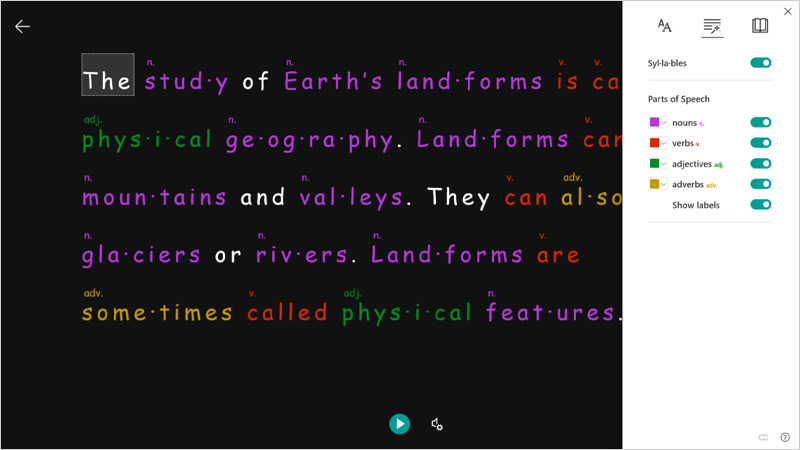Thanks to the evolution of education technology, more students with learning difficulties are finding accommodations that help them thrive in the classroom and in life.
That was the experience of Elle-Mae (Elle) Taylor. The third-year student at a United Kingdom university learned during her first year there that she had dyslexia, but it was prior to that when she discovered Immersive Reader, a digital learning tool from Microsoft that helped address some of the challenges she was having in school. The tool not only improved her confidence and well-being as her learning-related stress declined, but also opened more possibilities for her future, including her options for higher education and perceptions about career choice.
“What Immersive Reader did was give me the ability to be on the same level as everyone else,” she says. It “helped me address certain challenges and made me more successful.”
Elle’s journey toward discovering her full potential as someone who just needed the right tools, techniques, and attention to improve her reading and writing shows how greater awareness and accessible technologies can make a big impact in students’ learning and broader lives, including people without learning differences. In the U.S. alone, 2.5 million students have learning disabilities—such as dyslexia, dysgraphia, and dyscalculia—that can affect their academic performance and progress and can contribute to emotional struggles. That grows significantly when including students in the United Kingdom and entire world. But assistive technology can also support how students feel about their learning and performance in areas where they struggle.
Some of Elle’s earlier school memories include being treated as less capable than others. She had messy handwriting and trouble with things like expressing her thoughts clearly in writing exams, so her educators encouraged her to focus less on academics and more on sports and performing arts. Though talented in the arts, she had a more academic career in mind and wondered if her love of technology—which she excelled at and found innovative and creative—could somehow intersect with that. She became a student eager to learn and perform better but discouraged by what felt like a lack of support and solutions.
This persisted in part because a diagnosis of dyslexia eluded Elle until she attended university. Though she’d always known it took her more time to process certain work, it wasn’t among the most common struggles she’d heard were tied to dyslexia, such as seeing or writing jumbled words on a page.
Things changed when Elle was introduced to Immersive Reader, which happened when she started using a computer for her studies during the latter part of high school, known as the “Sixth form” in the United Kingdom. Her school’s accessibility services department made her aware of the tool, which she says changed the course of her life forever.

Immersive reader supports diverse learning styles.
Elle became able to recognize her mistakes and refine her work using a variety of Immersive Reader features that she learned about over time. She used a page color feature that changes the background color of the page and line focus to allow users to better concentrate on one sentence of text at a time, and the Read Aloud function, which uses text-to-speech to help users hear what their writing sounds like. These and other features helped her better understand online texts she had to read for school and tackle sentence structure. Previously, when she had to hand-write for homework and exams, she’d have to spend extra time thinking through how. But features such as Dictation in Word allowed her to write essays by speaking them into her computer, which made it easier to get ideas down and then check for accuracy and clarity by hearing it with Read Aloud.
Immersive Reader also helped Elle’s self-expression. “It really transformed the success of my essays. I came out of A-Levels [Advanced Level Qualifications] getting the highest mark you can get,” she says. This reshaped her future. “When I started getting better grades, I was able to go to a really good university.”
That gave Elle easier access to the learning disability assessment she needed to reveal dyslexia. “When I had my dyslexia assessment, I was told that my reading and writing was really good, so it was almost like I had been overcoming a lot of the challenges by myself.”
Elle’s career outlook changed course. Because she could use assistive technology like Immersive Reader while taking courses on data and information systems, she was able to explore more options and pursue technology as she’d hoped. And her increased confidence “led me to be able to apply for other types of jobs in tech or business,” Elle says. She applied for an internship at Microsoft, hoping to learn and do more within the realm of using technology to increase student accessibility and equity.
Now, Elle is thriving as a Microsoft intern and still uses Immersive Reader to check emails before sending, and in other small ways in everyday life. At Microsoft, Elle has been involved in a variety of work. She has presented with the Microsoft Education Team to help customers determine which Microsoft Education solutions, including the accessibility tools, could benefit them. She has also founded a TechHer Coding Day, ensuring the day was accessible, to provide resources and guidance aimed at encouraging more women and non-binary students to pursue a career in technology.
“I think it can help in so many ways,” Elle says of Immersive Reader, including alleviating pressure on students who “are so stressed and exhausted” these days. “It could help any student. I don’t think they need to have dyslexia or another learning difficulty,” says Elle. “I think if more students knew about it, they would use it.”
With Microsoft’s built-in learning tools, students everywhere can have the assistive technology they need. Learn more about how Microsoft learning tools might benefit your students.







